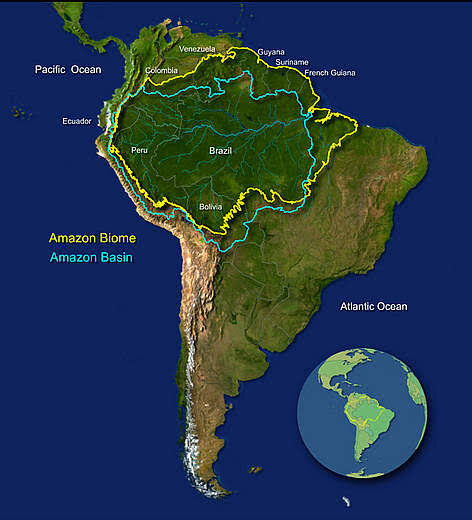Amazon Rainforest | 23 Aug 2019
According to the data from Brazil's National Institute for Space Research (INPE), the Amazon Forests in Brazil has experienced 74,155 fires since January 2019.
- This is an 85% increase from the last year (2018) and significantly higher than that in the year 2016, when there were severe drought conditions in the region associated with a strong El Nino event.
- Moreover, there is nothing abnormal about the climate this year or the rainfall in the Amazon region, which is just a little below average.
- These are large tropical rainforest occupying the drainage basin of the Amazon River and its tributaries in northern South America and covering an area of 6,000,000 square km.
- Tropical forests are closed-canopy forests growing within 28 degrees north or south of the equator.
- They are very wet places, receiving more than 200 cm rainfall per year, either seasonally or throughout the year.
- Temperatures are uniformly high - between 20°C and 35°C.
- Such forests are found in Asia, Australia, Africa, South America, Central America, Mexico and on many of the Pacific Islands.
- Comprising about 40% of Brazil’s total area, it is bounded by the Guiana Highlands to the north, the Andes Mountains to the west, the Brazilian central plateau to the south, and the Atlantic Ocean to the east.
Reason Behind the Fires
- Natural Cause: The dry season creates favourable conditions for the use and spread of fire.
- Man-made causes: Since the 1960s, the Amazon has witnessed large-scale deforestation because of cattle-ranching, logging, power projects, mining and farming.
- The Amazon has large reserves of gold and other minerals.
- Immediate Cause: Environmentalists have blamed farmers setting the forest alight to clear land for pasture.
- The President of Brazil has repeatedly said that he believes that Brazil should open the Amazon up to business interests, to allow mining, agricultural and logging companies to exploit its natural resources.
Concerns
- The Amazon rainforest is a repository of rich biodiversity and produces approximately 20% of oxygen in the Earth’s atmosphere.
- It is home to many indigenous communities, their life depends on the forests.
- Additional Carbon Emissions: Carbon intake by the Amazon basin matches the emissions released by nations in the basin. The burning of forests, therefore, implies additional carbon emissions.
- Further deforestation could lead to Amazon’s transformation from the world’s largest rainforest to a savanna, which would reverse the region’s ecology.
- Savanna is a vegetation type that grows under hot, seasonally dry climatic conditions and is characterized by an open tree canopy (i.e., scattered trees) above a continuous tall grass understory (the vegetation layer between the forest canopy and the ground).
- The largest areas of savanna are found in Africa, South America, Australia, India, Myanmar (Burma)–Thailand region in Asia, and Madagascar.
- Impact on Water Cycle: Amazon rainforest has the ability to produce at least half of the rain it receives. The rain produced by the Amazon travels through the region and even reaches the Andes mountain range.
The United Nations and the international community need to take serious measures to save the forests.

